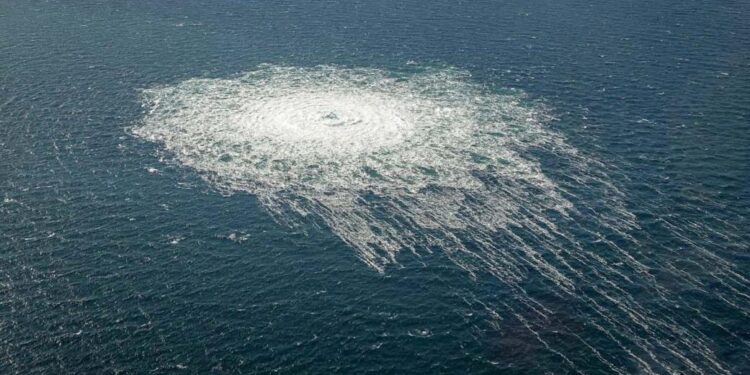Mounting evidence points to bombs planted by Putin’s forces
The Russian navy carried out at least two covert operations in the vicinity of the Nord Stream gas pipelines in the weeks before they were crippled by a series of explosions at the bottom of the Baltic sea, according to a detailed reconstruction of events.
Three of the four conduits, built to pump Russian natural gas directly to northern Germany, were blown open by powerful underwater blasts on September 26, in an apparent act of sabotage.
Investigators have yet to definitively identify the perpetrator. Numerous theories have surfaced, ranging from a “pro-Ukrainian” cell working without Kyiv’s knowledge to a false-flag attack under the auspices of the CIA.
Over the past few weeks, however, there has been mounting evidence that the bombs may have been planted by a submarine belonging to a Russian naval unit that carried out three clandestine manoeuvres near the site of the explosions last year, the latest of which took place on September 22.
The last of these Russian missions, which appears to have involved as many as half a dozen vessels, was closely monitored by the Danish navy and came to light in March.
Now a group of Nordic journalists led by Danmarks Radio, Denmark’s public broadcaster, has pieced together two other Russian operations in the same area.
The vessels, including the Sibiryakov, a hydrographic sea-surveying ship that is believed to carry a small submarine, were travelling in “dark” mode, having switched off the transponders that normally broadcast their positions.
However, their movements can be inferred from intercepted communications traffic, corroborated by satellite images.
At the centre of the investigation are the radio signals each ship sent between three and five times a day identifying their position, speed and direction of travel to Russia’s Baltic naval bases.
These were obtained by an anonymous former intelligence officer in the British navy, who has been using legal methods to intercept and analyse the radio updates.
They showed that various Russian ships made concealed trips to the area at least three times in the months before the Nord Stream sabotage, including in June and September last year.
“The presence of Russian naval vessels with underwater capabilities near the Nord Stream pipelines on three separate occasions in 2022 is highly suspicious,” the naval analyst told DR.
The first set of manoeuvres began on June 6, when one of the ships set out from the Baltiysk naval base in Kaliningrad, a Russian military exclave between Poland and Lithuania, and then circled over the Nord Stream pipelines to the east of the Danish island of Bornholm, coming within three miles of the locations where the bombs would go off three and a half months later.
A week after that it was joined by the Sibiryakov, which had come from a second Russian naval base at Lomonosov near St Petersburg.
The Sibiryakov exchanged radio messages with the first ship, and spent a day hovering over more or less the same positions. Satellite photographs also suggest the presence of another “ghost ship” similar in size.
Analysts said this stage might have been the initial phase of preparations for a sabotage operation.
“It needs to be pointed out that these are not civilian vessels leased by the company behind Nord Stream and sent out to examine the pipes,” Johannes Riber, a naval officer and analyst at the Norwegian Defence Academy, told DR. “They are state-owned ships from Russia and they are out there for a reason, which, at any rate, is not maintenance work.”
The intercepted radio transmissions also confirm that a third Russian ship, a tug called the SB-123, which carries a crane powerful enough to winch bulky objects down to the sea floor, visited the area on September 21 and 22.
Experts said the Sibiryakov, while notionally built for sea and ocean research, was well-equipped for covert underwater warfare missions.
“It is a ship with underwater operating capacity that can send things down to the seabed,” said Jens Wenzel Kristoffersen, a Danish navy captain and analyst at the University of Copenhagen. “It has [submarine] equipment, a crane for lowering things into the water and a room for operating [the submarine]. It is able to locate, confirm and map what lies on the seabed.”
The German, Swedish and Danish authorities, which are each carrying out their own separate investigation into the Nord Stream explosions, have been tight-lipped about the results so far.
The Swedish public prosecutor’s office said it had established a “good overview” of the relevant maritime traffic but could not reveal more at this time.
Russia’s foreign ministry and Nordic embassies declined to comment on the report. However, the Kremlin has previously denied that Russia had anything to do with the Nord Stream bombing.
Source: The TImes


Recent Comments